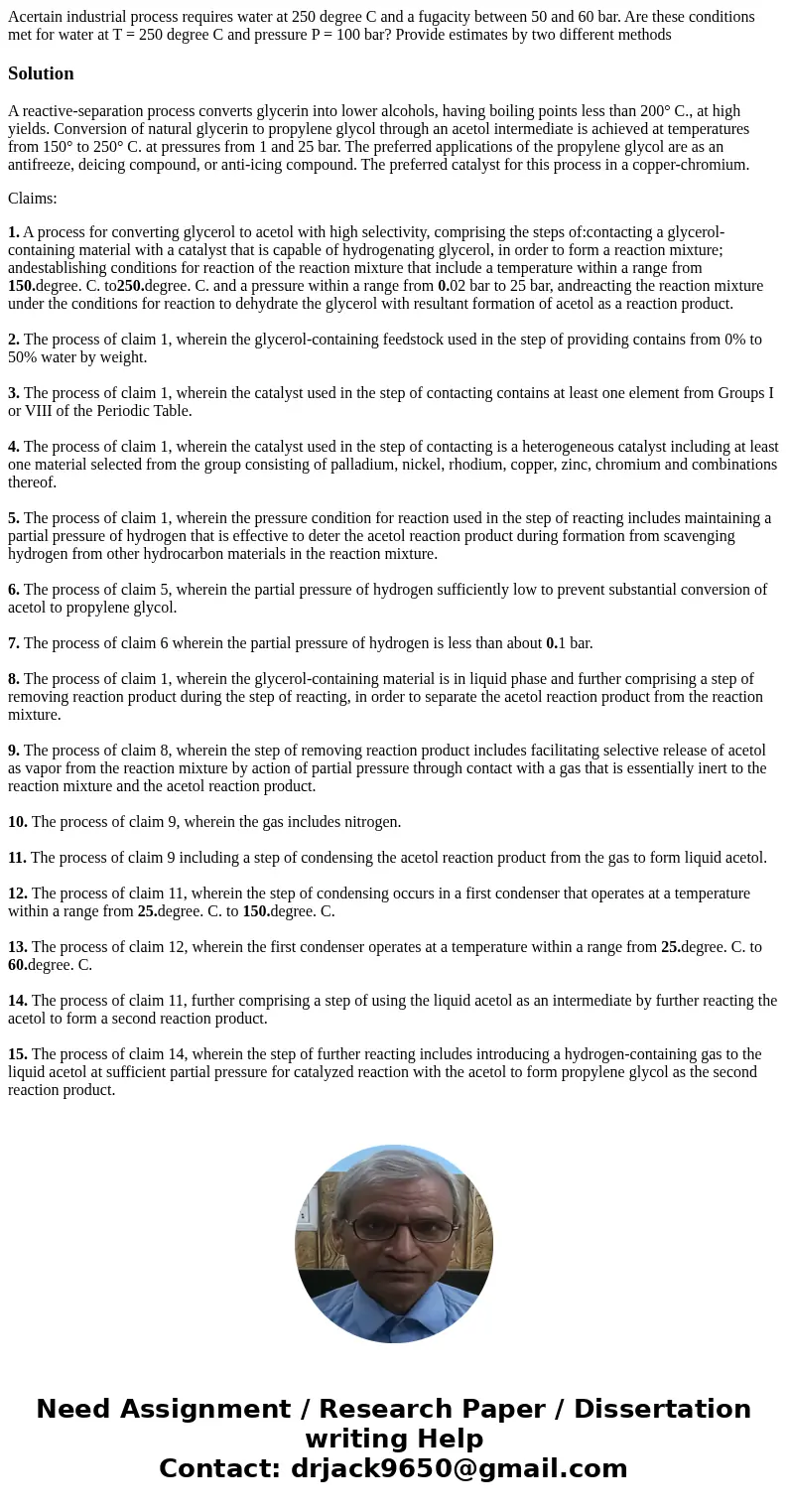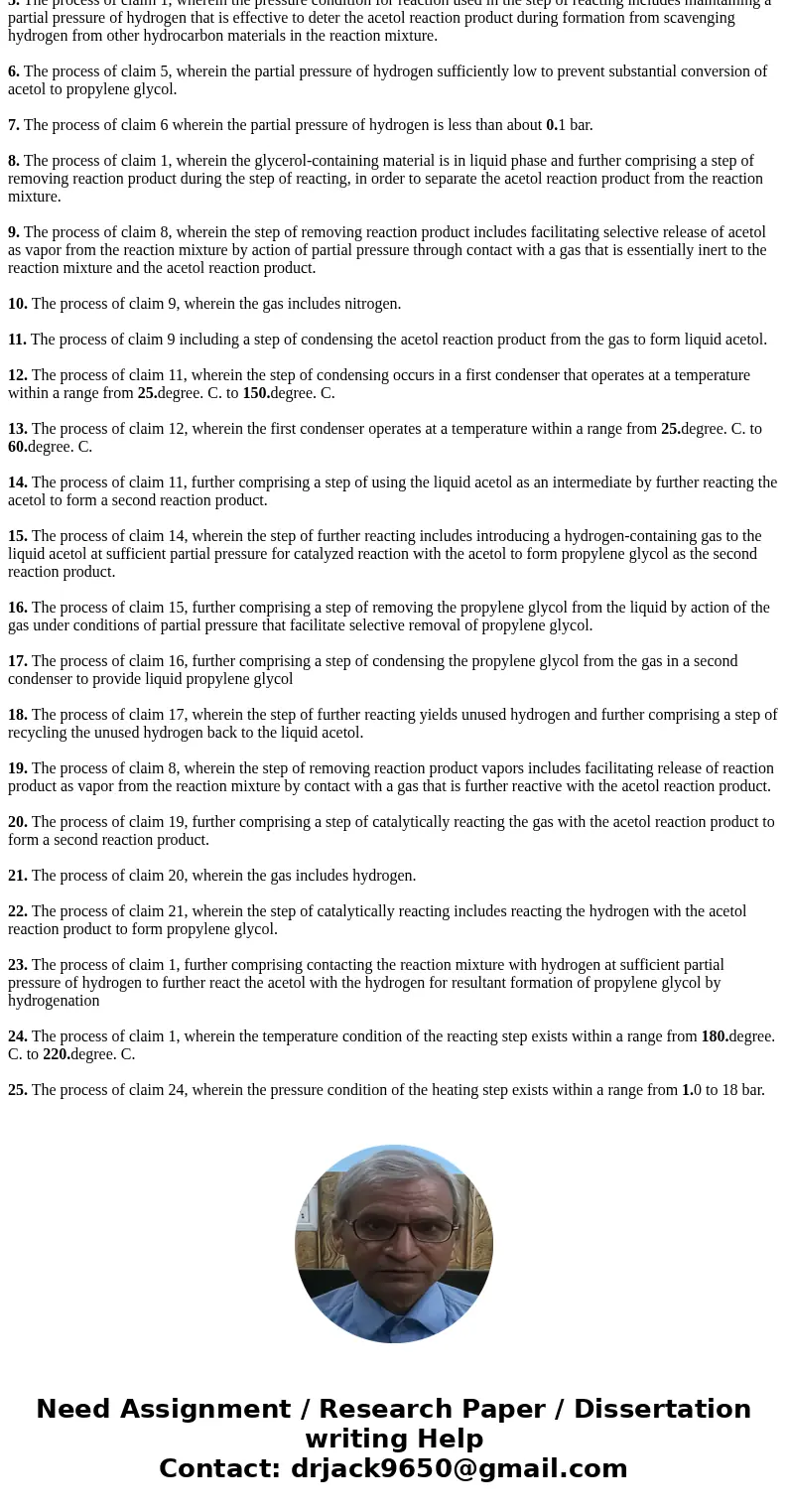Acertain industrial process requires water at 250 degree C a
Solution
A reactive-separation process converts glycerin into lower alcohols, having boiling points less than 200° C., at high yields. Conversion of natural glycerin to propylene glycol through an acetol intermediate is achieved at temperatures from 150° to 250° C. at pressures from 1 and 25 bar. The preferred applications of the propylene glycol are as an antifreeze, deicing compound, or anti-icing compound. The preferred catalyst for this process in a copper-chromium.
Claims:
1. A process for converting glycerol to acetol with high selectivity, comprising the steps of:contacting a glycerol-containing material with a catalyst that is capable of hydrogenating glycerol, in order to form a reaction mixture; andestablishing conditions for reaction of the reaction mixture that include a temperature within a range from 150.degree. C. to250.degree. C. and a pressure within a range from 0.02 bar to 25 bar, andreacting the reaction mixture under the conditions for reaction to dehydrate the glycerol with resultant formation of acetol as a reaction product.
2. The process of claim 1, wherein the glycerol-containing feedstock used in the step of providing contains from 0% to 50% water by weight.
3. The process of claim 1, wherein the catalyst used in the step of contacting contains at least one element from Groups I or VIII of the Periodic Table.
4. The process of claim 1, wherein the catalyst used in the step of contacting is a heterogeneous catalyst including at least one material selected from the group consisting of palladium, nickel, rhodium, copper, zinc, chromium and combinations thereof.
5. The process of claim 1, wherein the pressure condition for reaction used in the step of reacting includes maintaining a partial pressure of hydrogen that is effective to deter the acetol reaction product during formation from scavenging hydrogen from other hydrocarbon materials in the reaction mixture.
6. The process of claim 5, wherein the partial pressure of hydrogen sufficiently low to prevent substantial conversion of acetol to propylene glycol.
7. The process of claim 6 wherein the partial pressure of hydrogen is less than about 0.1 bar.
8. The process of claim 1, wherein the glycerol-containing material is in liquid phase and further comprising a step of removing reaction product during the step of reacting, in order to separate the acetol reaction product from the reaction mixture.
9. The process of claim 8, wherein the step of removing reaction product includes facilitating selective release of acetol as vapor from the reaction mixture by action of partial pressure through contact with a gas that is essentially inert to the reaction mixture and the acetol reaction product.
10. The process of claim 9, wherein the gas includes nitrogen.
11. The process of claim 9 including a step of condensing the acetol reaction product from the gas to form liquid acetol.
12. The process of claim 11, wherein the step of condensing occurs in a first condenser that operates at a temperature within a range from 25.degree. C. to 150.degree. C.
13. The process of claim 12, wherein the first condenser operates at a temperature within a range from 25.degree. C. to 60.degree. C.
14. The process of claim 11, further comprising a step of using the liquid acetol as an intermediate by further reacting the acetol to form a second reaction product.
15. The process of claim 14, wherein the step of further reacting includes introducing a hydrogen-containing gas to the liquid acetol at sufficient partial pressure for catalyzed reaction with the acetol to form propylene glycol as the second reaction product.
16. The process of claim 15, further comprising a step of removing the propylene glycol from the liquid by action of the gas under conditions of partial pressure that facilitate selective removal of propylene glycol.
17. The process of claim 16, further comprising a step of condensing the propylene glycol from the gas in a second condenser to provide liquid propylene glycol
18. The process of claim 17, wherein the step of further reacting yields unused hydrogen and further comprising a step of recycling the unused hydrogen back to the liquid acetol.
19. The process of claim 8, wherein the step of removing reaction product vapors includes facilitating release of reaction product as vapor from the reaction mixture by contact with a gas that is further reactive with the acetol reaction product.
20. The process of claim 19, further comprising a step of catalytically reacting the gas with the acetol reaction product to form a second reaction product.
21. The process of claim 20, wherein the gas includes hydrogen.
22. The process of claim 21, wherein the step of catalytically reacting includes reacting the hydrogen with the acetol reaction product to form propylene glycol.
23. The process of claim 1, further comprising contacting the reaction mixture with hydrogen at sufficient partial pressure of hydrogen to further react the acetol with the hydrogen for resultant formation of propylene glycol by hydrogenation
24. The process of claim 1, wherein the temperature condition of the reacting step exists within a range from 180.degree. C. to 220.degree. C.
25. The process of claim 24, wherein the pressure condition of the heating step exists within a range from 1.0 to 18 bar.


 Homework Sourse
Homework Sourse